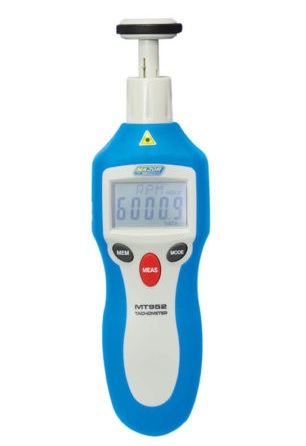A tachometer is a device used to measure the rotational speed of a rotating object, typically expressed in revolutions per minute (RPM). They are used in various applications, including automobiles, aircraft, industrial machinery, and laboratory equipment, to monitor speed and prevent damage.
Here’s a more detailed overview:
What it measures:
-
Rotational Speed:The primary function of a tachometer is to measure how fast a rotating shaft, disc, or other rotating part is turning.
-
Units:The most common unit for rotational speed is RPM (revolutions per minute).
-
Applications:
- Automotive: In cars, tachometers indicate engine speed and can help drivers determine when to shift gears.
- Aircraft: In airplanes, tachometers monitor engine speed to ensure safe and efficient operation.
- Industrial Machinery: Tachometers are used in factories and power plants to monitor the speed of motors, pumps, and other machinery.
- Laboratories: They are used to calibrate the speed of centrifuges, grinders, and other equipment.
- Automotive: In cars, tachometers indicate engine speed and can help drivers determine when to shift gears.
-
Types:
- Analog: Use a needle and dial to display the RPM.
- Digital: Display RPM on a screen, offering more precise readings.
- Contact and Non-Contact: Contact tachometers make direct contact with the rotating part, while non-contact tachometers use methods like lasers to measure speed without physical contact.
- Analog: Use a needle and dial to display the RPM.
Why it’s important:
-
Monitoring Speed:Tachometers help monitor the speed of rotating parts to ensure they are operating within safe and optimal ranges.
-
Preventing Damage:By monitoring speed, tachometers can help prevent equipment damage caused by overspeed or underspeed conditions.
-
Maintaining Efficiency:In engines, tachometers help maintain optimal speed for efficient fuel consumption and performance.
-
Calibration:In laboratory settings, tachometers are used to calibrate the speed of equipment for accurate experimentation.
The MT952 is a combination non-contact and contact digital tachometer for convenient, fast and accurate measuring of high rotational speeds up to 100 000 rpm. The MT952 is supplied standard with an adaptor that converts the MT952 into a tachometer for measuring surface and axial speeds. The meter is capable of various measurements such as Rotation Speed, Total Revolutions, Frequency, Surface speed and length. The instrument is ideally suited for use with engines, process machinery, motors and machine tools.
Features :
- Combination non-contact and contact digital tachometer for convenient, fast and accurate measuring of high rotational speeds up to 100 000 RPM
- RPM Contact range 2 – 20 000RPM
- RPM Non-contact range 2 – 100 000RPM
- Detecting distance 50 – 500mm
- 5 Digit backlit LCD
- Auto Range
- Data Hold
- 40 Reading Memories
- Min / Max / Avg
- Resolution 0.1 RPM
- Built-in laser spot

